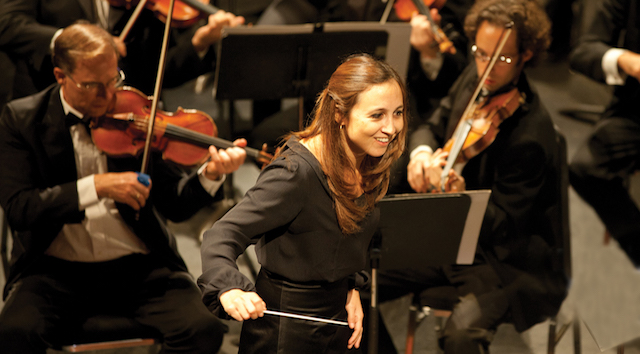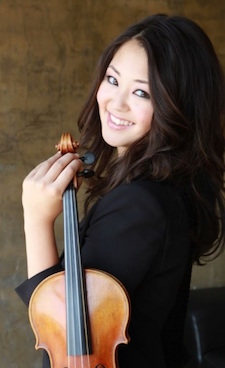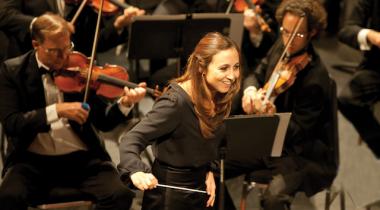
“It’s alive!” screams Colin Clive as the eponymous scientist in the classic 1931 Frankenstein film. Unfortunately for composer Mark Grey, his recently composed Frankenstein opera is still awaiting that jolt of lightning to bring his creation to life — while Brussels’ Théâtre Royal de la Monnaie was due to premiere the work next month, the production has been put off to a later, undetermined date.
Yet the audience at Berkeley’s Zellerbach Hall on Thursday witnessed a twitch of life for Grey’s “creature” of an opera. In its final mainstage concert, the Berkeley Symphony Orchestra and conductor Joana Carneiro presented the West Coast premiere of the composer’s Frankenstein Symphony, itself a kind of Frankenstein’s monster made up of stitched-together musical material from the yet-to-be-performed opera.
Grey and his librettist Júlia Canosa i Serra envisioned an adaptation of the story closer to the original Mary Shelley novel than the slightly campy monster flick featuring a big-headed, bolt-necked Boris Karloff. However, the pair made a slight alteration to the tale, moving the story’s framing narrative to 2216. Instead of Victor Frankenstein narrating the horror tale, it is the creature himself, who has been frozen in the Arctic ice for four centuries.
Grey’s symphonic reduction opens with the same material as the opera, depicting the monster’s reanimation. The short but dramatic introduction of this “Genesis” movement was particularly operatic, calling to mind the opening of Richard Strauss’ Elektra and passages from Mussorgsky’s Boris Godunov. What followed was more typically symphonic — slow and expansive, with strains of Wagnerian horn melodies rising out of the low strings. It had the character of some dark, nebulous, slow movement from a late-Romantic symphony by Bruckner or Sibelius.
Yet Grey’s music didn’t exactly develop in the traditional symphonic style. Rather, he created what could be called “atmospheres” or “soundscapes.” His themes were often halfway between ostinato and melody. These he layered on top of one another to create thick polyphonic textures, out of which emerged meandering lines from the brass or woodwinds.
This kind of immersive aural space is likely drawn from Grey’s work as an opera sound designer. Among numerous other collaborations, the composer has produced sound designs for his friend and colleague John Adams (who was in the audience), including productions of the latter’s Nixon in China and Doctor Atomic. Adams’ stage music seems to have also rubbed off on Grey as there were moments in the Frankenstein Symphony that sounded straight from the opening sequence of Nixon.
Grey’s musical textures captured the Gothic mystery and melancholy of Shelley’s story. Some of the movements imperceptibly built toward bombastic climaxes with heavy use of blaring trombone and tuba, yet these were moments of frustration, of angst rather than terror. There was nothing that really captured the extreme fear we associate with the Frankenstein myth: no screeching Psycho strings, no suffocating Ligeti or Penderecki cluster chords, no sadistic Rite of Spring rhythms. Grey may have been hoping to cast Frankenstein’s creature as sympathetic and misunderstood rather than a horror-movie boogeyman. Yet this portrayal resulted in a slightly moody and inactive score. It was music continually on the verge of something that never quite arrived — music of endless, brooding transition rather than of overwhelming, sublime terror.
Neither was it particularly theatrical. Apart from a few dancelike themes in the third movement, “The Lab,” and a somewhat hummable arioso in the last movement, “The Body” (which depicts Victor mourning over the corpse of his beloved Elizabeth), there was nothing that felt like it belonged to the stage — it was more background, film-score music than operatic action. Grey in his program note explained that he wanted to shy away from a typical, best-hits concert version of the opera in favor of something more idiomatically symphonic.
But converting all of the vocal material to instrumental writing may have been a bad move. The symphony would have been more engaging had Grey left the text in place, scoring the work for singers and orchestra rather than orchestra alone. The unsung bits of Júlia Canosa i Serra’s promising libretto were included in the program for the listener to read along with the symphony, yet very few of Grey’s instrumentalized themes sounded as if they could be vocal settings of that text.

The second half of the program was devoted to the Tchaikovsky Violin Concerto, played by 19-year-old Simone Porter. The opening movement felt like a typical prodigy performance — show-stopping and virtuosic, but devoid of originality. However, Porter’ personality shone through in the folksy second and third movements. The opening melody of the slow movement was subdued and subtle, evoking images of a Russian grandmother singing a lullaby, a slight tremor in her voice. Likewise, Porter brought out the rustic energy of the final movement’s folk dance. As her career progresses, the young violinist would do well to drop the Tchaikovsky in favor of some grittier, less “polished”-sounding repertoire with more character and room for individuality — perhaps some Bartók or Shostakovich.
Readers can hear a broadcast of the concert on Monday, May 30 at 9:00 pm on 91.7 FM KALW.

